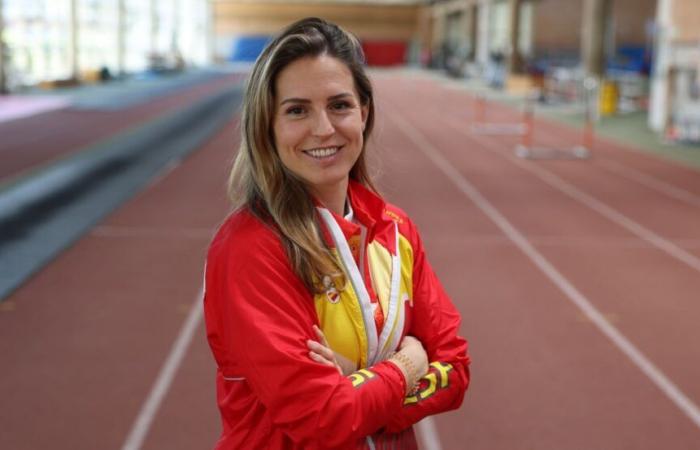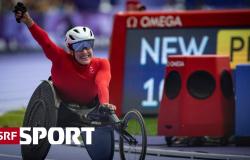Look – he points to his arm while his skin crawls – it makes my hair stand on end.The one speaking is the Paralympic athlete Sara Andres (Madrid, 1986). Her skin reacts if she imagines bringing a medal back from Paris. “These Games are going to be very special, being so close to all our family and friends, and I think the stadium is going to be packed, so secondly, that’s a great thing… and thirdly, that the medals have a little piece of the Eiffel Tower on them.”well it’s like… I want to die! So I wish I could have that little piece at home.”
There are few athletes who transmit as much as this sprinter from Madrid who was photographed a few months ago by the famous photographer Annie Leibovitz. It is no coincidence that on her website she describes herself as speaker motivational… A while with her is reconciling. There are not that many influencers able to impact so positively on their followers. On the one hand, through their Instagram account, where they have more than 37 thousand followers and openly shows her daily life and her sense of humor.
“I do it because I’m that clown-like. In my case, I show what I want and what I can on a daily basis, my jokes, my attitude, and if that can be useful to someone, great, but I don’t want to be a role model or see myself as such. My goal is not to teach you, or teach you, or show you how you have to see or treat me,” he tells Relevo.
On the other hand, through her job as a teacherin which she is a true influencer for her primary school studentsalthough she is now on leave. “Sport has an age, but I can return to being a teacher whenever I want,” she says. Despite the distance, her students closely follow her achievements through social networks or on visits she makes to their school in Madrid. “They love sport and I think that thanks to seeing me they have also become interested in athletics.” That first day when she explained to them that she was a Paralympic athlete… and also that she had a disability is long gone.
“I had already been to Rio, I had competed in the World Championships in London, and I was afraid that they would find out through the media that I had no feet. So one day in class I talked to them about Paralympic sport, I showed them videos, photos, and at one point I said ‘this is me’. I lifted my skirt and showed them the prosthetics,” she recalls.
And then came the funny reactions of his six-year-old pupils. “There were many who said ‘how cool, we have a robot teacher’, but others… ‘My God, I’m so scary, I don’t want to get close to you’ -she laughs-. There were quite a few reactions, but after five or ten minutes it was already supernatural and they understood it perfectly. That is how easy it is for children to accept things as they come and adapt to everything.” The teacher became their superheroine… Because, like in all those comics, drawings and films that her students like so much, everything begins with a previous tragedy. In this case, as real as it is painful.
In 2011, he suffered a double amputation of his legs, below the knees, due to a traffic accident. At 25 years old She suddenly had to face a new way of life. “Of course, I faced the disability much later than other Paralympic athletes. There are colleagues who have it from birth and perhaps they have assimilated it more. It is also true that I was a mature girl, I had my job, I had where to lean on… but at first it was a shock, nobody expects this kind of thing, and then, when you face it, you realize that you are much stronger than you think. I mean, There are people who tell me ‘oh, I couldn’t do it’. Surely they can, but you just haven’t been in that situation, And when you see yourself there, you realise that what really matters is not that you are missing a pair of feet, a hand or your eyesight. What is important is to enjoy the things you like, to be with the people you love, to love, to be loved… That is not given or taken away by a pair of feet.”
“You realize that you are much stronger than you think”
Sara Andres
Athlete
Before the accident, she had always played sports. Karate, tennis, pelota and even horse riding. But athletics did not come into her life until this new normal. “It’s kind of absurd and counterproductive, isn’t it? I mean, I don’t have feet and I make the joke and I say to myself ‘but choose something else, something with arms!'”once again shows off his good humor.
In fact, her arrival in Paralympic athletics was part of a natural process. First she had to learn to walk with her prostheses. Then, as she wanted to continue playing sports, she learned to run… And then love at first sight happened: “That’s it, I’ve chosen my sport. It was a plus, a new open door with possibilities I had never dreamed of, it made my life a little more complete, “It gave me the opportunity to travel, to meet other people, to compete abroad, to learn the sport…”
And he hasn’t done badly:world bronze in the 100 meters in Kobe in 2024, a year earlier he hung the silver in Paris in the same testbronze in the 200 and 400 m at London 2017, record holder in the 100 m long jump in 2019 and the 200 m in 2021. And now he has added another Paralympic Games to his prostheses, his third after Rio 2016 and Tokyo 2020.
“The Dutch are my main rivals because they work very hard and well and also because They are very tall -Fleur Jong is 1.90 m tall while the Spanish woman is 1.60 m tall-. So, of course, the higher the stride, the better… Since I’m short, I’ll try to do it more frequently and run more – she laughs, once again.
Behind that eternal smile there is a person who He has overcome thyroid cancer and skin cancer that almost kept him out of Rio. “In my motivational talks I do talk about how I overcame thyroid and skin cancer, but I haven’t talked much about it on social media,” she admits.
And also, a threat of retreat: Paris comes after an Olympic cycle of reflection that began after Tokyo. “I had to take some time off to think about whether I wanted to continue, because “I came back mentally crushed by the results.”
“After Tokyo I had to take some time to think about whether I wanted to continue”
Sara Andres
Athlete
It wasn’t like that. She changed her trainer, now she is accompanied by Sara Montero and she has rediscovered the sport.
“We started with an attitude of enjoying ourselves more than of achieving a goal. I think that is the way, that you are comfortable and that you enjoy what you do. And it is very important to train, but with the desire… There are a lot of messages out there right now about the more you train, the more hours, the better you will be. Well, no.because there is a part of training that is rest, that invisible trainingwhich is personal care, mental care, nutritional care. So, the one who does it best is the one who knows how to balance his professional side with quality training and the personal side of taking care of yourself and surrounding yourself with people who do you good, surrounding yourself with that environment that also makes you disconnect from athletics. It works for me, with those guidelines I know that I am in my best shape, I know that I am calm, happy, and that I am enjoying what I do: running.”
With this contagious happiness, Sara Andrés competes in her third Games in search of that little piece of the Eiffel Tower.





